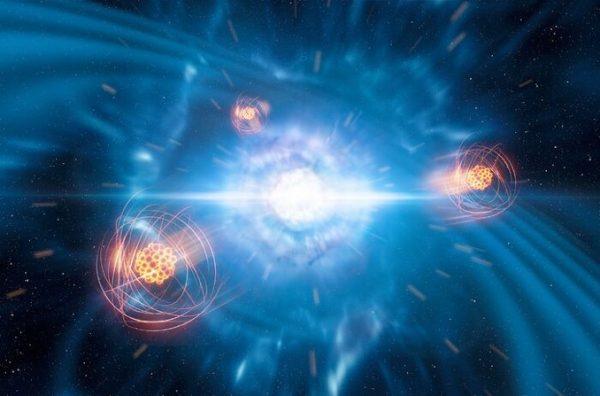Heavy element creation confirmed in neutron star merger – Astronomy Now Online

Probing light from a kilonova blast in the wake of a cataclysmic neutron star merger, astronomers have identified strontium in spectra captured by the X-shooter instrument on the European Southern Observatory’s Very Large Telescope, confirming heavy elements are indeed formed in such extreme events.
The source, known as GW170817, was detected by gravitational waves in 2017, triggered by the merger of two neutron stars. The X-shooter instrument and others monitored the emerging kilonova blast, on the lookout for heavy elements. While there were indications of such elements, researchers were unable to isolate individual signatures until now.
“By reanalysing the 2017 data from the merger, we have now identified the signature of one heavy element in this fireball, strontium, proving that the collision of neutron stars creates this element in the universe,” said Darach Watson of the University of Copenhagen, lead author of a paper in the journal Nature.
“This is the final stage of a decades-long chase to pin down the origin of the elements,” he said. “We know now that the processes that created the elements happened mostly in ordinary stars, in supernova explosions, or in the outer layers of old stars. But, until now, we did not know the location of the final, undiscovered process, known as rapid neutron capture, that created the heavier elements in the periodic table.”
Rapid neutron capture, also known as the r-process, requires atomic nuclei to capture neutrons fast enough to build up heavy elements. While many elements are produced in the cores of stars, its takes an extreme-energy environment with massive numbers of neutrons to form elements heavier than iron.
The neutron star merger now known as GW170817 blew away an expanding shell of debris moving at up to 30 percent the speed of light. In one second, more than 1022 neutrons passed through an area of one square centimetre. As the blast proceeded, heavy elements were created, including five Earth masses of strontium alone.
“This is the first time that we can directly associate newly created material formed via neutron capture with a neutron star merger, confirming that neutron stars are made of neutrons and tying the long-debated rapid neutron capture process to such mergers,” said Camilla Juul Hansen from the Max Planck Institute for Astronomy in Heidelberg.
GW170817 was the fifth event detected by gravitational waves and so far, the only one with a visible counterpart within reach of Earth-based instruments.





